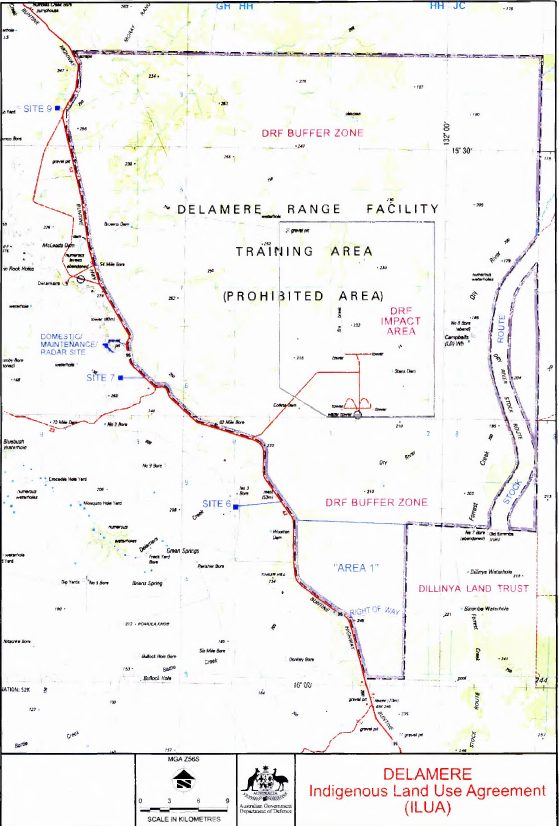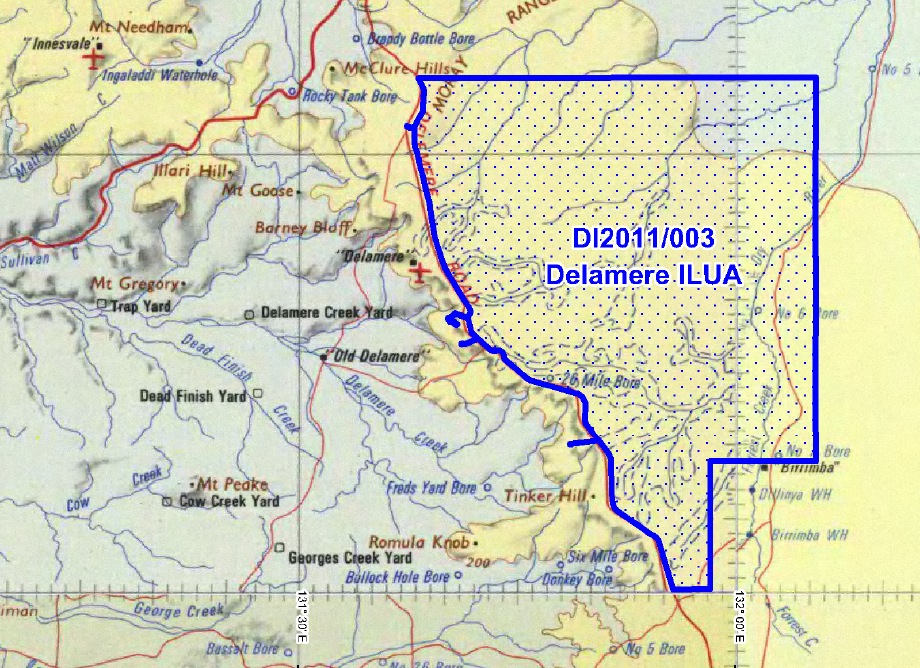Introduction
In December 2014 a US Air Force B-52 bomber, along with a KC-135 refueling tanker, landed in Darwin, and took part in simulated bombing exercises at the Delamere Air Weapons Range. This was the fourth B-52 mission to Darwin between 2012 and 2014.
Location
15°37’50″S, 131°51’43″E
Delamere Range Facility Airport: Latitude:-15.747 Longitude:131.91999

Michael Leunig, “I love a sunburnt country”, with apologies to Dorothea Mackellar, The Age, 16 December 2006

Delamere ILUA, Summary Plan of Delamere Range Facility, Source:http://www.nntt.gov.au/Indigenous-Land-Use-Agreements/Search-Registered-ILUAs/ILUA%20Register/2011/DI2011.003/DI2011_003_Delamere%20ILUA_%5BSchedule%202%5D_Summary%20Plan%20of%20Delamere%20Range%20Facility.pdf
GOVERNMENT SOURCES
Australia
Tindal offers ‘wow’ flying for visiting top guns, Lyndon Keane, Katherine Times, 22 October 2014
As part of Exercise Arnhem Thunder, about 140 members of No. 77 Squadron have converged on RAAF Base Tindal for three weeks of training, utilising the Delamere Air Weapons Range and the Bradshaw Field Training Area. “It’s basically our once-a-year bombing camp, so we use the Delamere range to the south-west of here, and Bradshaw out to the west, which are facilities we don’t have access to in Newcastle readily,” he told the Katherine Times.
“Williamtown is good, but it’s restrictive, and here is anything but restrictive. Where as here, you just take off and, wow, fantastic. It’s different here. The trees here are smaller, so when you low fly, you obviously see the trees rushing past and, because the trees are smaller, you can actually get too low, because you’re waiting for the same ground rush, but the trees aren’t as big.”
Australia’s premier spot to drop bombs, Corporal Simone Liebelt, RAAF News, Volume 47, No.14 August 11, 2005
“Delamere is undoubtedly the premier air weapons range in Australia; all Aussie aircrew as well as visiting ones acknowledge that. The fact that we can provide the facilities we do and have virtually unrestricted airspace provides terrific training value for them”, said Range Safety Officer, Squadron Leader Howard Robertson.
“We’re totally surrounded by cattle properties and there’s no major air routes that come through here, so strike aircraft have a freedom to practice tactics that is not readily available elsewhere,” he said.
“They’ve got 200,000 hectares of ground space out here and we get a clearance in airspace to 60,000 feet so aircraft can operate fully within those confines.
“For the US Marines [on Exercise Southern Frontier], who haven’t dropped [F/A-18] bombs for a while, they come and do some dummy passes initially, then go on to using practice bombs and culminate in dropping high explosives.
Gunnery with the aircraft’s 20mm cannon is also an added dimension.”
He told me Delamere had two practice ranges for rockets, guns and practice bombs, a high explosive range, a large mass inert weapon range, a simulated airfield complex and “Tac Town”, which is a township constructed from shipping containers.
“From the air, Tac Town looks like a township and the different buildings simulate different roles,” he explained.
“There’s a special forces headquarters, a school, a church, a power generator and a Town Hall; so it forces crews to plan a mission just as if they were attacking an enemy town, and having to consider all the rules of engagement implications.
“Future directions for the range include a radar feed to provide me with a greater level of awareness of aircraft positions within the area, and a series of tactical ranges for use by the Army’s Tiger helicopter when it comes into service. The Range will only get better as time goes by.”
United States
B-52 lands in Australia for training, Brian Everstine, Air Force Times, 11 December 2014
An Air Force B-52, along with a KC-135 refueling tanker, landed in Australia on Monday to train with the Royal Australian Air Force. This marks the fourth time a Superfortress has landed down under since 2012.
The U.S. and Australia in 2011 agreed on a joint Force Posture Initiative to train together to face threats in the Pacific. The B-52, assigned to Andersen Air Force Base, Guam, and deployed from Minot Air Force Base, North Dakota, touched down at Royal Australian Air Force Base Darwin. The Air Force has bombers deployed to Guam on a constant rotational basis. The training mission will include simulated ordnance drops at the Delamere Training Range and a fighter intercept exercise, according to Pacific Air Forces.
“Enhancing” the Australian-U.S. Defense Relationship: A Guide to U.S. Policy, Thomas-Durell Young, Strategic Studies Institute, U.S. Army War College, November 17, 1997.
Delamere Air Weapons Range. Located 80 nautical miles southwest of RAAF Base Tindal (which itself is 330 kilometers south of Darwin), is the RAAF’s principal air weapons range. Delamere is approximately one-half million acres (approximately 30 miles by 40 miles). It has the advantage of having no significant environmental limitations and is located well outside of the cyclone belt. On the downside, the RAAF finds its flat terrain a limit to training. The RAAF is planning to expand the range by purchasing the rest of the Delamere Station. The Department of Defence has not yet endorsed the concept and the
RAAF is considering going alone as did the army in pressing for the purchase of Bradshaw. The RAAF’s reluctance in the early 1990s to having U.S. aircraft using RAAF Base Tindal and Delamere has softened markedly. Senior RAAF Base Tindal leadership stated that U.S. access and usage are welcome, Australian resource limitations considered.
PARLIAMENTARY SOURCES
Australia’s Defence Relations with the United States, Joint Standing Committee on Foreign Affairs, Defence and Trade, 22 May 2006.
4.20 Defence continued by describing the nature of the JCTC [Joint Combined Training Centre] when they stated:
A mature JCTC should not be seen as a test range or even a series of ranges. The JCTC should function as a training system that links training management systems, training areas, simulations, headquarters and units. It is proposed that the JCTC should be linked to the US Pacific Command’s Pacific Warfighting Center and the US Joint Force Command’s Joint National Training Capability as part of the US Global Joint Training Infrastructure. The JCTC concept envisages the enhancement of a number of Australia’s ranges, including SWBTA, Bradshaw Field Training Area and the Delamere Range Facility. Ultimately these ranges could be networked through a series of interoperable systems and interfaces, enabled by advances in information technology.
ANALYSIS
Coming To A Country Very Close To You, Brendan Nicholson, The Age, 19 November 2005.
Giant American strategic bombers will practise long-range raids on Australia under an agreement enabling the US to “project power” into the region. The bombers will hit the Delamere bombing range in the Northern Territory under an agreement signed yesterday at the Australia-United States ministerial summit in Adelaide. Training will start in the new year and involve bombers travelling a considerable distance to use the ranges and flying home without landing. Others would land and use facilities at Darwin.
B-52s participate in Green Lightning, Australian air show, Military Press, 28 March 2007.
Andersen Airmen flew to the land ‘down under’ this week to demonstrate the capability and flexibility of the B-52 Stratofortress bomber to their Australian partners. They completed a series of scheduled Green Lightning exercise sorties at the Delamere Bombing Range while also providing aerial flyovers for the Australian International Airshow 2007 in Victoria, Australia. The missions over Australia were flown under two different types of mission profiles. The Green Lightning missions were 12-hour, round-trip flights into the Delamere Bombing Range beginning and ending here. Later missions saw a B-52, along with a KC-135 Stratotanker for support, landing at the Royal Australian Air Force Base Darwin to fly sorties supporting the Australian air show. “We departed Andersen and received 80,000 pounds of fuel from the KC-135 tanker accompanying us,” said Capt. Mike Maginness, a B-52 co-pilot with the 96th Expeditionary Bomb Squadron. “We continued our mission to the Delamere Bomb Range where we received permission to employ six BDU-50 inert bombs.” This was the third time Andersen-based bombers have participated in the Green Lightning exercise. B-2 Spirit bombers completed the first Green Lightning exercise from Guam in July 2006, while the first group of B-52s completed their sorties in October 2006.
Project coordinator: Richard Tanter
Updated: 12 December 2014


